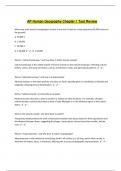AP Human Geography Chapter 1 Test Review
What map scale would a cartographer choose if one inch of road on a map represents 54,000 inches on
the ground?
A. 54,000:1
B. 1:54,000
C. 24,000: 1
D. 1:24,000 ✔️✔️B. 1:54,000
What is "cultural landscape," and how does it reflect human activity?
Cultural landscape is the visible imprint of human activity on the natural landscape, reflecting cultural
beliefs, values, and social structures, such as architecture, roads, and agricultural patterns. ✔️✔️
What is "absolute location," and how is it determined?
Absolute location is the exact position of a place on Earth, typically given in coordinates of latitude and
longitude, allowing precise identification. ✔️✔️
Define "relative location" and provide an example.
Relative location describes a place's position in relation to other locations. For example, Chicago’s
relative location could be described as west of Lake Michigan or in the Midwest region of the United
States. ✔️✔️
What is the "gravity model," and what does it predict?
The gravity model predicts the level of interaction between two places based on their populations and
the distance between them, suggesting that larger, closer places interact more than smaller, farther
ones. ✔️✔️
What is "map projection," and why does it matter in geography?
Map projection is the method of transferring Earth’s 3D surface to a 2D map, which often results in
distortion of shapes, areas, or distances, affecting the accuracy of geographic representation. ✔️✔️
,What is "ethnocentrism," and how can it affect geographic perception?
Ethnocentrism is the belief in the superiority of one's own culture, which can shape perceptions and
biases toward other regions, potentially leading to misunderstandings and cultural stereotypes. ✔️✔️
What is the purpose of a "remote sensing" technology in geography?
Remote sensing technology captures images and data from satellites or aircraft to monitor
environmental changes, track land use, and assess natural disasters, providing valuable geographic
information. ✔️✔️
Explain "location" in the context of geography and its significance.
Location refers to the specific position of a place on Earth’s surface, playing a crucial role in
understanding spatial relationships, accessibility, and the interaction between places. ✔️✔️
What is "population density," and how is it calculated?
Population density is the measure of people per unit area, calculated by dividing the population by the
area. It helps indicate how crowded or sparsely populated a region is. ✔️✔️
What does "pattern" refer to in spatial analysis?
Pattern in spatial analysis refers to the arrangement or distribution of objects in space, whether regular,
clustered, or random, which can reveal important insights into geographic processes. ✔️✔️
Define "formal region" and provide an example.
A formal region is an area defined by a shared physical or cultural trait, like a country with specific
political boundaries or the Corn Belt in the United States known for agricultural production. ✔️✔️
What is the significance of "latitude" and "longitude" in geography?
Latitude and longitude are coordinate systems that allow for pinpointing locations on Earth, with
latitude indicating distance north or south of the equator and longitude measuring east or west of the
Prime Meridian. ✔️✔️
, What is "diffusion," and what are its primary types in human geography?
Diffusion is the spread of ideas, innovations, or cultural elements across space. The primary types are
relocation diffusion, hierarchical diffusion, contagious diffusion, and stimulus diffusion. ✔️✔️
How does "GIS" differ from "GPS"?
GIS (Geographic Information System) is a tool for analyzing and visualizing spatial data, while GPS
(Global Positioning System) is a navigation system that provides precise location data using satellites.
✔️✔️
What is "distance decay" and its impact on communication?
Distance decay is the principle that interaction between places diminishes as distance increases, leading
to decreased communication and exchange over longer distances. ✔️✔️
What is "environmental determinism," and why is it considered outdated?
Environmental determinism suggests that the environment directly shapes human behaviors and
cultural development. It is considered outdated because it overlooks human agency and adaptability.
✔️✔️
Explain the concept of "time-space compression" with an example.
Time-space compression refers to the reduction of perceived distance due to advancements in
technology, such as the internet enabling instant communication across continents. ✔️✔️
What are "cognitive maps," and why are they significant?
Cognitive maps are mental representations of spatial layouts, based on personal experience and
knowledge, helping individuals navigate and make sense of their surroundings. ✔️✔️
Define "urban sprawl" and its geographic implications.
Urban sprawl is the uncontrolled expansion of urban areas into rural land, leading to environmental
concerns, increased commute times, and the loss of green spaces. ✔️✔️
What is "fieldwork" in human geography, and why is it important?




